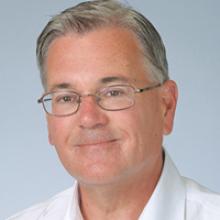LAS VEGAS—At the American Academy of Neurology’s Fall 2016 Conference, Robert M. Pascuzzi, MD, presented several case videos to illustrate recent advances in caring for patients with rare neuromuscular disorders, including myasthenia gravis, Lambert-Eaton syndrome, Duchenne muscular dystrophy, and amyotrophic lateral sclerosis (ALS). Dr. Pascuzzi is Chair of the Department of Neurology at Indiana University School of Medicine in Indianapolis.
Myasthenia Gravis
The first case, a 55-year-old woman with a six-month history of double vision and swallowing trouble, also expressed the Cogan lid twitch, which is “pathognomonic for myasthenia gravis,” Dr. Pascuzzi said.
“It’s nice to have a test to confirm your clinical suspicions,” he said, noting that antibodies to the acetylcholine receptor (AChR) yield “almost perfect specificity” for myasthenia gravis. Other antibodies in use or under study to confirm this diagnosis include muscle-specific kinase (MuSK), low-density lipoprotein receptor-related protein 4 (LRP4), agrin, and cortactin.
The recently completed International Thymectomy Trial, which followed 126 patients for three years, found that those randomly assigned to transsternal thymectomy plus prednisone versus prednisone alone had significantly improved clinical outcomes, as measured on the Quantitative Myasthenia Gravis scale. Patients also required less prednisone, 44 mg versus 60 mg (alternate days), and fewer patients in the thymectomy group required azathioprine (17% versus 48%) or were hospitalized for exacerbations (9% versus 37%).
“Up until this study, nobody was completely sure this treatment worked,” Dr. Pascuzzi said.
Lambert-Eaton Syndrome
In the second case, a woman presented with a six-month history of falling down after her legs gave out on her. She also complained of dry mouth and, on examination, had proximal weakness and no muscle stretch reflexes.
Serology and EMG testing confirmed Lambert-Eaton myasthenic syndrome, a paraneoplastic syndrome. Half the patients with this syndrome have small cell carcinoma, Dr. Pascuzzi said, usually lung, due to smoking. In 64% of cases, the SOX1 antibody is positive.
Treatment approaches include treating the cancer; and 3,4 diaminopyridine, pyridostigmine, and immunotherapy.
Duchenne Muscular Dystrophy
A six-year-old boy with progressive clumsiness was found to have Duchenne muscular dystrophy, a diagnosis with “huge” genetic implications for his three younger brothers, Dr. Pascuzzi said. By age 20, patients are usually on ventilators.
Recently, the FDA granted accelerated approval to the first drug to treat Duchenne muscular dystrophy—Exondys 51 (eteplirsen). The drug “is specifically indicated for patients who have a confirmed mutation of the dystrophin gene amenable to exon 51 skipping, which affects about 13% of the population with Duchenne muscular dystrophy,” the FDA noted.
However, eteplirsen is not without controversy, Dr. Pascuzzi said. “There’s no documented clinical benefit. If you show there is a little more dystrophin being deposited and built in muscle, what does that mean? As of today, nobody knows. So that is an issue I think the FDA Advisory Panel and other people are worried about. And then, at $300,000 a year, it is not a financially insignificant impact.”
As the drug is used, further studies and data “will eventually show that it does or does not have clinical benefit,” Dr. Pascuzzi said. Patients must undergo testing for the mutation. Reported adverse events include balance issues and vomiting.
Amyotrophic Lateral Sclerosis
The third and fourth cases focused on a 53-year-old man with 12 months of progressive decline in speech and swallowing, and a woman with similar symptoms who also would laugh for no apparent reason. Both cases were displaying the pseudobulbar affect of ALS.
About 5% to 10% of all ALS cases are familial and, in 40% to 50%, the most common gene is C9orf72. Less common is the SOD1 gene (20%), with those carrying its A4V mutation generally dying within one year. Other mutations include TDP-43 (5%), and FUS (5%).
Dr. Pascuzzi cautioned that cognitive impairment among patients with ALS can be as high as 40% and cannot usually be detected on a bedside exam. Up to 15% of patients “get a frank, overt, clinically significant dementia, usually a frontotemporal syndrome.”
Treatment approaches include use of multidisciplinary clinics, ankle-foot orthosis, tools for activities of daily living, bilevel positive airway pressure, chin tuck, and power chairs; drugs include riluzole, dextromethorphan/quinidine for pseudobulbar affect, and drugs for spasticity.
He said it is important to address fear, depression, and anxiety in patients with ALS, and not to overlook the caregiver: “We are slowly but surely melting down our caregivers.”
A recent study in Lancet Neurology helped Dr. Pascuzzi and colleagues decide against diaphragm pacing for patients with respiratory insufficiency due to ALS, due to the potential for harm. “I would be cautious about pursuing this,” he said.
Despite the many failed controlled trials over the past 20 years, much investigational work is being done on ALS therapeutics, from injection of antisense molecules to tirasemtiv to stem cells, immune therapy, neuro-protection, and high fat/calorie diet, “so there is reason to be hopeful.”
Stem cell transplantation, in particular, is something he said his patients always ask him about. Two forms, “both important,” have undergone fairly extensive clinical investigation.
In the first, spinal cord-derived neural stem cells are transplanted into the spinal cord.
“The people that drive this work are convinced this is not stem cells that turn into motor neurons and replace lost or failing motor neurons, but instead these are stem cells that provide an environment that is more favorable for sick motor neurons,” Dr. Pascuzzi said. “They secrete nerve growth factors and transport proteins to improve the environment.”
The second approach, autologous stem cell treatment, is a “culture-based method for inducing mesenchymal stem cells to secrete neurotrophic factors,” he said, which has been “shown to be protective in several animal models of neurodegenerative diseases.”


